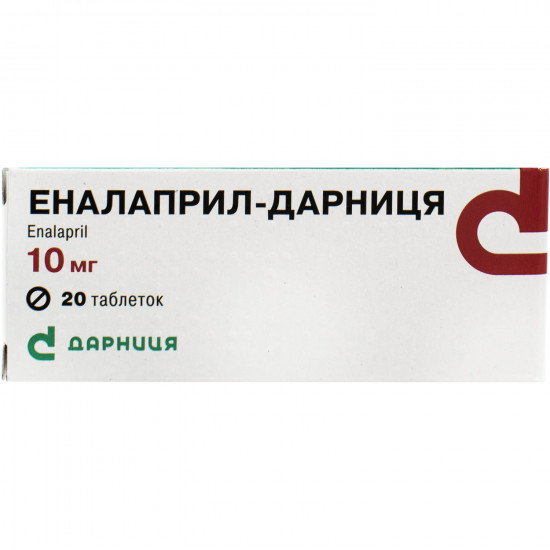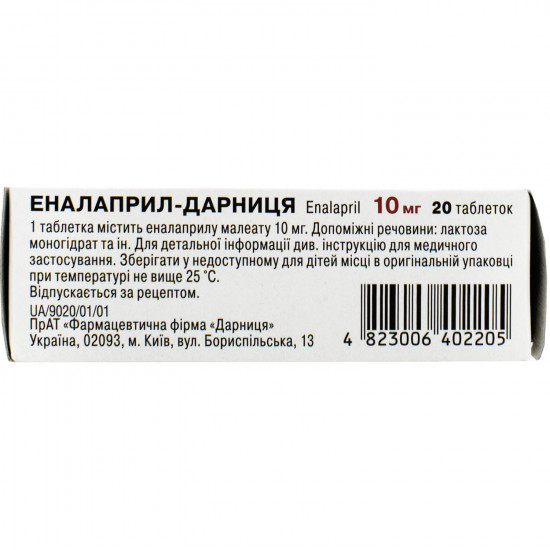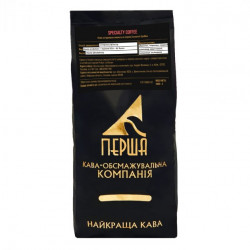



- Stock: In Stock
- Model: 182532
0% Customers recommend this product
-
5 Awesome0%
-
4 Great0%
-
3 Average0%
-
2 Bad0%
-
1 Poor0%
Reviews Over Enalapril-Darnitsa tab. of 10 mg No. 20
- (0)
Total Reviews (0)
click here write review to add review for this product.
Report this review.
Description
tablets Enalapril-Darnitsa are applied at the following indications:
- Treatment of arterial hypertension.
- Treatment of clinically apparent heart failure.
- Prevention of clinically apparent heart failure at patients with asymptomatic dysfunction of a left ventricle (fraction of emission ≤ 35%).
Structure
Active ingredient: enalapril;
1 tablet contains enalapril of a maleate 10 mg;
Excipients: microcrystalline cellulose, potato starch, lactose monohydrate, calcium stearate.
Contraindication
- Hypersensitivity to enalapril, to any excipient or to the APF any other inhibitor.
- Existence in the anamnesis of the Quincke's disease connected with use of APF inhibitors.
- Hereditary or idiopathic Quincke's disease.
- should not apply enalapril with the medicaments containing aliskiren, to patients with diabetes or with renal failures (SKF <60 ml/min. / 1.73 m 2 ).
- Pregnant women or women who are going to become pregnant.
- should not accept enalapril within 36 hours after transition with to reception of a sakubitrila/valsartan, the medicament containing inhibitor of a neprilizin.
Route of administration
to take the Pill entirely, washing down with a small amount of water, irrespective of meal. Enalapril-Darnitsa it is necessary to accept daily at the same time and not to exceed the recommended dose.
Tablet on 10 mg can be divided, in case of purpose of a dose of 5 mg to use ½ tablets.
At patients with the system which is very activated renin-angiotensin-aldosteronovoy (for example with renovascular hypertensia, disturbance salt and or liquid balance, a decompensation of warm function or heavy arterial hypertension) perhaps excessive falling of arterial blood pressure after reception of an initial dose. The initial dose of 5 mg or below is recommended to such patients, and the initiation of treatment has to pass under observation of the doctor.
Feature of use
Pregnant
Drug should not be used by pregnant women or women who are going to become pregnant.
ChildrenMedicine is intended by
only to children with arterial hypertension, but it is not recommended for use at other indications. to apply
Enalapril-Darnitsa to children is more senior of 6 years.
enalapril is not recommended bydue to the lack of data for treatment of children with the level of glomerular filtration less than 30 ml/min. / 1.73 to m 2 .
Drivers
Should considerthat there can sometimes be dizziness or arterial hypotension which can affect speed of response at control of motor transport or work with other mechanisms.
OverdoseData on overdose at people are limited to
.
Symptoms. The most probable manifestation of overdose is hypotension which begins in 6 hours after reception of tablets, in parallel with blockade renin-angiotenzinovoy of a system and a stupor. The symptoms characteristic of overdose include shock from a cardiovascular system, an electrolytic imbalance, a renal failure, a hyperventilation of lungs, tachycardia, a cardiopalmus, bradycardia, dizziness, sensation of fear, cough. Enalapril levels in blood serum exceed the levels observed after use of therapeutic doses, after reception of 300 mg and 440 mg of enalapril respectively in 100 and 200 times.
Treatment. Performing intravenous infusion of 0.9% of solution of sodium of chloride is recommended. At appearance of arterial hypertension of the patient it is necessary to put in horizontal position. In case of need it is necessary to appoint infusion of angiotensin II and/or intravenous administration of catecholamines. If reception took place recently, it is necessary to take the measures directed to enalapril removal (vomiting, gastric lavage, introduction of sorbents and sodium of sulfate).
Enalapril can be brought out of system blood circulation by means of a hemodialysis.
toIn the bradycardia resistant to therapeutic means, showed therapy by means of a pacemaker. It is necessary to control constantly important vital signs, concentration of electrolytes and level of creatinine in serum.
Side effects
- from organs of sight: misting of sight.
- from organs of hearing and a vestibular mechanism: a ring in ears, vertigo.
- from the respiratory system, bodies of a thorax and mediastinum: cough, short wind, rhinorrhea, pharyngitis, dysphonia, sore throat, hoarseness, bronchospasm/asthma, infiltrate of lungs, rhinitis, allergic alveolitis / eosinophilic pneumonia.
- from digestive tract: nausea, diarrhea, abdominal pain, change of taste, impassability of intestines, pancreatitis, vomiting, dyspepsia, a constipation, anorexia, irritation of a stomach, dryness in a mouth, round ulcers, stomatitis / aphthous ulcers, a glossitis, a Quincke's disease of digestive tract.
- from a liver and biliary tract: liver failure; hepatitis is hepatocellular or cholestatic; gepatonekroz; a cholestasia, including jaundice.
- from kidneys and an urinary system: renal failure, renal failure, proteinuria, oliguria.
- from an endocrine system: syndrome of disturbance of secretion of antidiuretic hormone.
- from a metabolism, metabolism: hypoglycemia.
- from nervous system: headache, depression, dizziness, confusion of consciousness, drowsiness, insomnia, nervousness, paresthesia, sleep disorders, sleep disorders, abnormal dreams.
- from a cardiovascular system: arterial hypotension (including orthostatic hypotension), a syncope, pain behind a breast, disturbances of a warm rhythm, stenocardia, tachycardia, heart consciousness, a myocardial infarction or a cerebral and vascular stroke (perhaps, secondary in excessive arterial hypotension at patients with high risk), Reynaud's syndrome.
- from blood and lymphatic system: anemia (including aplastic and hemolytic), a neutropenia, decrease in level of hemoglobin, decrease in a hematocrit, thrombocytopenia, an agranulocytosis, oppression of function of marrow, a pancytopenia, a lymphadenopathy, autoimmune diseases.
- from skin and hypodermic cellulose: rashes, hypersensitivity / Quincke's disease: it was reported about a Quincke's disease of the face, extremities, lips, language, a glottis and/or throat; the strengthened sweating, an itching, urticaria, an alopecia, a polymorphic erythema, Stephens-Johnson's syndrome, exfoliative dermatitis, a toksikodermalny necrolysis, a pempigus, an erythrosis. to
- It was reported about a complex of symptoms which can include the following symptoms: fever, a serositis, a vasculitis, a myalgia/miositis, arthralgia/arthritis, positive take on antinuclear antibodies, increase the blood sedimentation rate (BSR), an eosinophilia, a leukocytosis. There can be rashes, photosensitivity or other dermatological manifestations.
- from the reproductive system and function of mammary glands: impotence, gynecomastia.
- General disturbances: an asthenia, increased fatigue, spasms in muscles, muscular spasms, inflows, sensation of discomfort, a fever.
Interaction
Alcohol enhances hypotensive effect of APF inhibitors.
Sympathomimetics can reduce antihypertensive effects of APF inhibitors.
Storage conditionsto Store
out of children's reach in original packing at a temperature not above 25 °C.
Expiration date - 2 years.
Specifications
| Characteristics | |
| Active ingredients | Enalapril |
| Amount of active ingredient | 10 mg |
| Applicant | Darnitsa |
| Code of automatic telephone exchange | C09AA02 Enalapril |
| Interaction with food | It doesn't matter |
| Light sensitivity | Not sensitive |
| Market status | Generic-generic |
| Origin | Chemical |
| Prescription status | According to the prescription |
| Primary packing | blister |
| Producer | DARNITSA CIAO PHARMACEUTICAL. FIRM |
| Quantity in packing | 20 tablets (2 blisters on 10 pieces) |
| Release form | tablets for internal use |
| Route of administration | Oral |
| Sign | Domestic |
| Storage temperature | from 5 °C to 25 °C |
| Trade name | Enalapril |








































